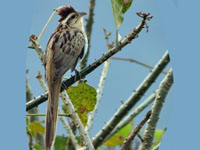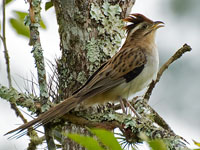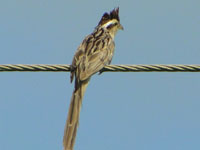The cuckoo family Cuculidae contains six subfamilies. The first three listed below are found in the New world, while the remaining three are found in the Old World.
* Coccyzinae – New World Cuckoos
* Neomorphinae – New World Ground Cuckoos
* Crotophaginae – Anis
* Cuculinae – Old World Cuckoos
* Phaenicophaeinae – Malkohas and Couas
* Centropodinae – Coucals
This article is about the Neomorphinae subfamily, which contains the New World ground-cuckoos. They are not closely related to the Asian ground-cuckoos of genus Carpococcyx.
There are 5 genera in this subfamily, but only 11 species. As the name implies, the ground-cuckoos spend much of their time on the ground. This has caused them to develop strong legs and many can run very fast. The fastest is the greater roadrunner which attains speed up to 40 km/h (25 mph). All of the ground-cuckoos eat insects and other anthropoids such spiders and crustaceans. Some are especially attracted by arm ants, masses of ants moving in one direction.
Only one species of New World ground-cuckoo is brood parasitic: thepavonine cuckoo (Dromococcyx pavoninus).
The cuckoo family Cuculidae
The cuckoo family Cuculidae is the only family of the order Cuculiformes. The family is represented on all continents except Antarctica. Most species reside in tropical or subtropical environments. Those in temperate locations migrate to avoid cool or cold winters. In addition to cuckoos, the family Cuculidae also includes the roadrunners, koels, malkohas, couas, coucals and anis. The coucals and anis are sometimes separated as distinct families. The cuckoos are generally medium sized slender birds. The majority are of the cuculidae family are arboreal, with a sizeable minority that is terrestrial.
Cuckoos are medium sized birds that range in size from 15-63 cm. There is generally little sexual dimorphism in size, but where it exists, it can be either the male or the female that is larger, depending on the genera. There are two basic body forms, arboreal species which are slender and terrestrial species which are more heavy set and have stronger legs. Almost all species have long tails which are used for steering in terrestrial species and as a rudder during flight in the arboreal species.
Many species are brood parasites, laying their eggs in the nests of other species, but the majority of species raise their own young. The brood parasitic birds usually only parasitize a single host species or a small group of closely related host species. They tend to remove a host egg when they lay one of their own in a nest. This both prevents the host species from realizing their nest has been parasitized and reduces food competition for the parasitic nestling once it hatches. Some brood parasites will eliminate all their nest-mates shortly after hatching. If the host removes a parasitic egg or chick, the adult parasitic birds may retaliate by destroying the nest.
There has been an evolutionary arms race between the cuckoos that leave their eggs in other nests, and the hosts that get these unwanted presents. The cuckoos have evolved to be able to lay their eggs faster than most other species and the eggs need less incubation time before hatching. These eggs often resemble the host eggs to prevent detection of an invader egg. The drongo-cuckoos resemble their host. Some hosts have evolve to be social so the colony can be on the lookout for an invader trying to deposit an egg. Others have more than one brood of chicks per year so there will be replacements for any losses due to cuckoos.
Cuckoos feed on insects, small animals, seeds, and fruit. For many cuckoo species, caterpillars are their favorite food; even hairy caterpillars that are avoided by most other birds. Cuckoos can consume hairy caterpillars because of their ability to shed their abdominal lining and get rid of the hairs via a pellet. Another favorite food of many cuckoos are grasshoppers. We may find it repugnant that some cuckooos are brood parasitic and they or their offspring even kill the host's chicks, but on the plus side cuckoos help prevent plagues of caterpillars and grasshoppers!
Almost all cuckoos are shy which can make them a challenge to observe and photograph. Consistent with this behavior, they are not colonial breeders. These traits may be have their roots in their brood parasitic behavior. Stealth is a good characteristic if you want to sneak an egg into a host's nest.
* Coccyzinae – New World Cuckoos
* Neomorphinae – New World Ground Cuckoos
* Crotophaginae – Anis
* Cuculinae – Old World Cuckoos
* Phaenicophaeinae – Malkohas and Couas
* Centropodinae – Coucals
This article is about the Neomorphinae subfamily, which contains the New World ground-cuckoos. They are not closely related to the Asian ground-cuckoos of genus Carpococcyx.
There are 5 genera in this subfamily, but only 11 species. As the name implies, the ground-cuckoos spend much of their time on the ground. This has caused them to develop strong legs and many can run very fast. The fastest is the greater roadrunner which attains speed up to 40 km/h (25 mph). All of the ground-cuckoos eat insects and other anthropoids such spiders and crustaceans. Some are especially attracted by arm ants, masses of ants moving in one direction.
Only one species of New World ground-cuckoo is brood parasitic: thepavonine cuckoo (Dromococcyx pavoninus).
The cuckoo family Cuculidae
The cuckoo family Cuculidae is the only family of the order Cuculiformes. The family is represented on all continents except Antarctica. Most species reside in tropical or subtropical environments. Those in temperate locations migrate to avoid cool or cold winters. In addition to cuckoos, the family Cuculidae also includes the roadrunners, koels, malkohas, couas, coucals and anis. The coucals and anis are sometimes separated as distinct families. The cuckoos are generally medium sized slender birds. The majority are of the cuculidae family are arboreal, with a sizeable minority that is terrestrial.
Cuckoos are medium sized birds that range in size from 15-63 cm. There is generally little sexual dimorphism in size, but where it exists, it can be either the male or the female that is larger, depending on the genera. There are two basic body forms, arboreal species which are slender and terrestrial species which are more heavy set and have stronger legs. Almost all species have long tails which are used for steering in terrestrial species and as a rudder during flight in the arboreal species.
Many species are brood parasites, laying their eggs in the nests of other species, but the majority of species raise their own young. The brood parasitic birds usually only parasitize a single host species or a small group of closely related host species. They tend to remove a host egg when they lay one of their own in a nest. This both prevents the host species from realizing their nest has been parasitized and reduces food competition for the parasitic nestling once it hatches. Some brood parasites will eliminate all their nest-mates shortly after hatching. If the host removes a parasitic egg or chick, the adult parasitic birds may retaliate by destroying the nest.
There has been an evolutionary arms race between the cuckoos that leave their eggs in other nests, and the hosts that get these unwanted presents. The cuckoos have evolved to be able to lay their eggs faster than most other species and the eggs need less incubation time before hatching. These eggs often resemble the host eggs to prevent detection of an invader egg. The drongo-cuckoos resemble their host. Some hosts have evolve to be social so the colony can be on the lookout for an invader trying to deposit an egg. Others have more than one brood of chicks per year so there will be replacements for any losses due to cuckoos.
Cuckoos feed on insects, small animals, seeds, and fruit. For many cuckoo species, caterpillars are their favorite food; even hairy caterpillars that are avoided by most other birds. Cuckoos can consume hairy caterpillars because of their ability to shed their abdominal lining and get rid of the hairs via a pellet. Another favorite food of many cuckoos are grasshoppers. We may find it repugnant that some cuckooos are brood parasitic and they or their offspring even kill the host's chicks, but on the plus side cuckoos help prevent plagues of caterpillars and grasshoppers!
Almost all cuckoos are shy which can make them a challenge to observe and photograph. Consistent with this behavior, they are not colonial breeders. These traits may be have their roots in their brood parasitic behavior. Stealth is a good characteristic if you want to sneak an egg into a host's nest.
Cuckoo family members are zygodactyl: they have the 2 inner toes facing forward and 2 two outer toes facing to the rear.
New World Ground-Cuckoos
Genus Dromococcyx
These two cuckoos have strikingly graduated tails, and are among the few cuckoos of the Americas that are brood parasites (the only other is the Striped Cuckoo).
Cuckoo,_Pavonine Dromococcyx pavoninus
Description: The Pavonine Cuckoo has dark-brown upperparts. and paler underparts. The head is rusty-brown. The eye-rings are white and the superciliums are buff. The throat and upper-breast are also buff. The tail is long and graduated (under-tail feathers display different lengths). It is brood parasitic; the single chick kills its nest mates. The pavonine cuckoo is similar to the pheasant cuckoo which has a paler throat and breast. The pheasant cuckoo also has dark marks and streaks on the breast while the former does not.
Range: South America.
Habitat: The understory of subtropical and tropical moist forests.
Diet: Mainly insects such as grasshoppers.
Conservation status: Least concern
Image by: 1, 2, 3) Dario Sanches - Brazil Range: South America.
Habitat: The understory of subtropical and tropical moist forests.
Diet: Mainly insects such as grasshoppers.
Conservation status: Least concern

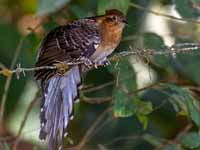
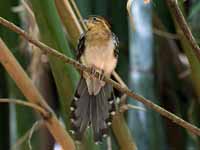
Cuckoo,_Pheasant Dromococcyx phasianellus
Description: The pheasant cuckoo has brown upperparts and paler underparts. The throat has small dark marks which help distinguish it from the similar pavonine cuckoo. The tail is long and graduated (under-tail feathers display different lengths). They are brood parasitic.
Range: Central and South America.
Conservation status: Least concern.
Image by: 1, 2) Cornell_Univ's_Neotropical_Birds_Online - Carlos_Echeverria in Guatemala, Andrew Spencer in Brazil Range: Central and South America.
Conservation status: Least concern.


Genus Geococcyx
There are two roadrunner species. Their name comes from the habit of racing down roads in front of moving vehicles and then darting to safety in the brush. They raise their own young.
Roadrunner, Greater Geococcyx californianus
Description: The greater roadrunner has streaked dark brown upperparts. It dark a brown crest with white specks and a very long dark tail. This is North America's largest cuckoo. It is similar to the smaller lesser roadrunner which has a shorter bill. If a roadrunner is found in the USA then it is a greater roadrunner.
Range: Southwest USA, Mexico.
Habitat: Desert scrub.
Diet: Insects, spiders, small snakes, mice and more.
Conservation status: Least concern.
Image by: 1) Alan D Wilson - Borrego Springs, California 2) Dick Daniels - North Carolina Zoo, 3, 4, 5) Dick - Tuscon, Arizona 6) dmallen321Range: Southwest USA, Mexico.
Habitat: Desert scrub.
Diet: Insects, spiders, small snakes, mice and more.
Conservation status: Least concern.
4) Note lizzard in the mouth

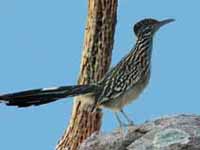
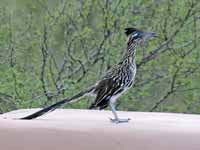
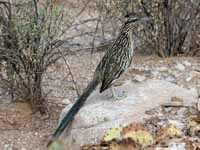

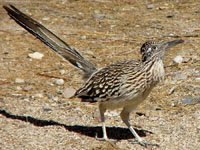
Roadrunner,_Lesser Geococcyx velox
Description: The Lesser Roadrunner has streaked dark brown upperparts. There is a dark brown crest with white specks and long dark tail. It is similar to the larger greater roadrunner which has a longer bill.
Range: Mexico and Central America.
Habitat: Open areas with scrub and thorny bushes.
Diet: Insects including grasshoppers and caterpillars; also seeds, fruit, frogs, small animals.
Conservation status: Least concern.
Image by: 1) Francesco Veronesi - Mexico 2) Sergey_Yeliseev 3) Mark_WatsonRange: Mexico and Central America.
Habitat: Open areas with scrub and thorny bushes.
Diet: Insects including grasshoppers and caterpillars; also seeds, fruit, frogs, small animals.
Conservation status: Least concern.
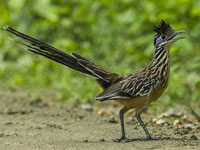
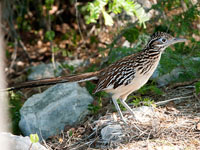

Genus Morococcyx - 1 species
Cuckoo,_Lesser_Ground- Morococcyx erythropygus
Description: The Lesser Ground-Cuckoo has dull brown upperparts with rufous tips to these feathers and the upper-tail coverts. The underparts are cinnamon and the tail is long and graduated. There is an ornate pattern on the face with a black mask on its sides.
Range: Mexico, Central America.
Habitat: Dry forest and scrub lands. This ground-cuckoo does spend some time low in the trees.
Conservation status: Least concern.
Image by: 1) Bryant_Olsen 2) Francesco Veronesi - Mexico 3) Nick Athanas - Costa RicaRange: Mexico, Central America.
Habitat: Dry forest and scrub lands. This ground-cuckoo does spend some time low in the trees.
Conservation status: Least concern.

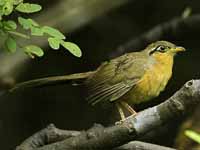
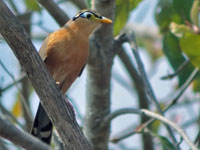
Genus Neomorphus
The New World ground-cuckoos look similar to the Old World ground-cuckoos, but they are not closely related. Their shape is also similar to the greater roadrunner. These New World birds are relatively large and mostly terrestrial, but they are shy and only infrequently seen. Because of their life for the ground they have powerful legs. They live in humid forests and often follows swams of army ants. The range of these five species do not overlap much and they can usually be distinguished by their bill and facial skin color.
Cuckoo,_Banded Ground- Neomorphus radiolosus
Description: The banded ground-cuckoo has a banded, scaly-looking face, mantle, and underparts. There is a black crest and the lower back is chestnut. The orbital skin is blue and the bill is dark.
Range: Columbia and Ecuador.
Habitat: Subtropical or tropical moist forests.
Diet: Insects, especially ants. Other anthropoids such as spiders and crustaceans.
Conservation status: The banded ground-cuckoo is endangered because of loss of habitat.
Image by: 1) Glenn Bartley - Cornell_Univ's_Neotropical_Birds_Online - Glenn_Bartley in EcuadorRange: Columbia and Ecuador.
Habitat: Subtropical or tropical moist forests.
Diet: Insects, especially ants. Other anthropoids such as spiders and crustaceans.
Conservation status: The banded ground-cuckoo is endangered because of loss of habitat.
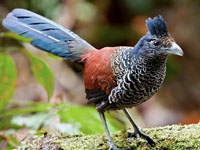
Cuckoo,_Red-billed ground- Neomorphus pucheranii
Description: The red-billed ground-cuckoo has a red bill and also red orbital skin around the eyes. There is also some blue on the orbital skin. The upperparts are brown with rufous wings. It has a black crown and crest. On the underparts the breast is grey and has a ruffled appearance. There is a black breast-band and the belly is cinnamon-buff,
Range: Amazon region of Brazil, Columbia, Ecuador, Peru.
Habitat: Moist forests.
Diet: Insects, especially ants. Also fruit.
Conservation status: Least concern.
Image by:
1) Francis Casteinau 2) Cornell_Univ's_Neotropical_Birds_Online-Whaldener_EndoRange: Amazon region of Brazil, Columbia, Ecuador, Peru.
Habitat: Moist forests.
Diet: Insects, especially ants. Also fruit.
Conservation status: Least concern.
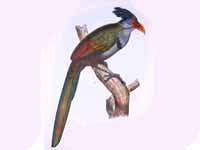
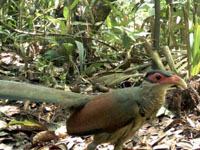
Cuckoo,_Rufous-vented Ground- Neomorphus geoffroyi
Description: The rufous-vented ground-cuckoo has dark upperparts with greenish, bluish, or purplish iridescence. The head is brown with a greenish-brown crest. There are whitish to pale tan underparts. The breast usually appears scaly and there is a thin black breast-band. As is true for other species in this genus, the tail is long and the legs are sturdy. The scaled ground-cuckoo has been considered a subspecies of the rufous-vented ground-cuckoo.
Range: Central and South Ameriaca.
Habitat: Floor of humid subtropical and tropical forests.
Diet: Insects, especially ants. Other anthropoids such as spiders and crustaceans.
Conservation status: The rufous-vented ground-cuckoo is listed as vulnerable as its numbers seem to be diminishing and the South American population may now be mostly restricted to Columbia. The remaining number of birds may be substantial, but their secretive nature makes this uncertain.
Image by: 1) Greg Kanies- Panama 2, 3) Cornell_Univ's_Neotropical_Birds_Online - Daniel_Teixeira in Brazil, John_Afdem in Panama 4) Dick Culbert - Argentina Range: Central and South Ameriaca.
Habitat: Floor of humid subtropical and tropical forests.
Diet: Insects, especially ants. Other anthropoids such as spiders and crustaceans.
Conservation status: The rufous-vented ground-cuckoo is listed as vulnerable as its numbers seem to be diminishing and the South American population may now be mostly restricted to Columbia. The remaining number of birds may be substantial, but their secretive nature makes this uncertain.
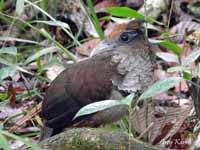
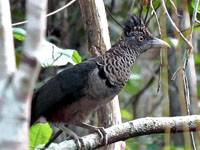
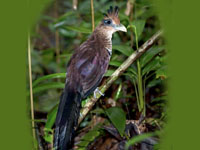
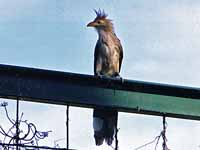
Cuckoo,_Rufous-winged Ground- Neomorphus rufipennis
Description: The rufous-winged ground-cuckoo has dark to black crown, crest, mantle, tail, and breast. The wings are rufous. The underparts are pale with scales. And as is true for others of his genus, the tail is long and the legs are sturdy.
Range: Northeastern South America.
Habitat: Humid tropical forests.
Diet: Insects, especially grasshoppers, crickets and spiders.
Conservation status: Least concern.
Image by: 1) Cornell_Univ's_Neotropical_Birds_Online - Pete_Morris in VenezuelaRange: Northeastern South America.
Habitat: Humid tropical forests.
Diet: Insects, especially grasshoppers, crickets and spiders.
Conservation status: Least concern.
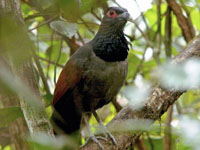
Cuckoo,_Scaled_Ground- Neomorphus squamiger
Description: The scaled ground-cuckoo has been considered a subspecies of the rufous-vented ground-cuckoo. Dark breast feathers outlined in white give it a scaled appearance. The belly also appear scaled, but less so. There is no breast-band. It has dark brown upperparts with a brown head that has a blackish crest. The tail is blackish and the belly tan.
Range: Amazon rainforest in Brazil. Also northern Bolivia, eastern Peru
Habitat: Forests - mainly terrestrial.
Diet: Insects, especially ants. Other anthropoids such as spiders and crustaceans.
Conservation status: Its status is vulnerable as the population continues to decline because of destruction of the rainforest.
Image by: 1, 2) Cornell_Univ's_Neotropical_Birds_Online - Jorge_Lopes in Brazil, Joao_Quenatal in BrazilRange: Amazon rainforest in Brazil. Also northern Bolivia, eastern Peru
Habitat: Forests - mainly terrestrial.
Diet: Insects, especially ants. Other anthropoids such as spiders and crustaceans.
Conservation status: Its status is vulnerable as the population continues to decline because of destruction of the rainforest.
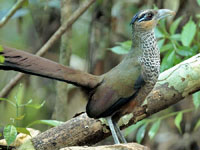
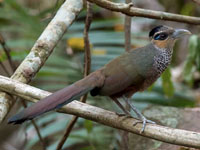
Genus Tapera - 1 species
Cuckoo,_Striped Tapera naevia
Description: The striped cuckoo has gray-brown upperparts, streaked with black and buff. There is a chestnut and black crest plus pale supercilium. The underparts are off-white. It is brood parasitic and one of three such cuckoos in the New World. The chick, or sometimes chicks, kills its nest mates.
Range: Southern Mexico, Central America, and much of South America.
Habitat: Open country with trees or shrubs, and the edges of mangrove forests.
Diet: Large insects such as grasshoppers.
Conservation status: Least concern.
Image by: 1) Nick Athanas - Costa Rica 2) Dario_Sanches 3) BarloventomagicoRange: Southern Mexico, Central America, and much of South America.
Habitat: Open country with trees or shrubs, and the edges of mangrove forests.
Diet: Large insects such as grasshoppers.
Conservation status: Least concern.
